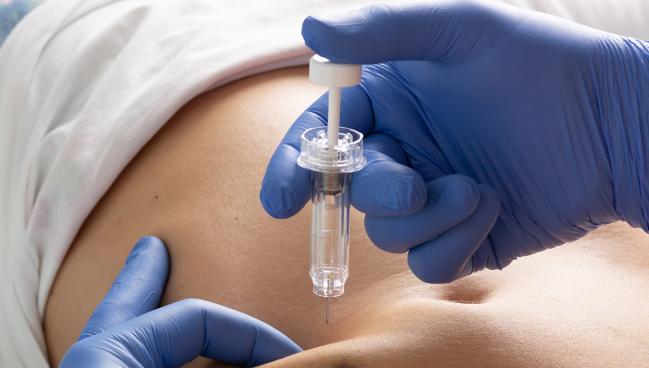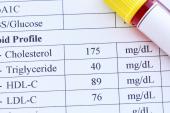Inclisiran Effective as Monotherapy for Lower-Risk Primary Prevention
With its twice-yearly dosing, the siRNA-based drug might lead to better compliance with treatment. Still, cost is an issue.

For low-risk patients not currently taking any lipid-lowering therapy, the use of inclisiran (Leqvio; Novartis) alone safely and effectively cuts LDL-cholesterol levels, the randomized VICTORION-Mono trial shows.
The study suggests that for certain patients—namely, those unwilling or unable to take a statin—a twice-yearly injection of inclisiran might be an option, say investigators.
“Statins are wonderful drugs, don’t get me wrong,” senior investigator R. Scott Wright, MD (Mayo Clinic, Rochester, MN), told TCTMD. “Statin therapy has really improved outcomes in atherosclerotic cardiovascular disease, but what we continue to see in practice is that a growing number of patients are statin-hesitant.”
In addition to that hesitancy, roughly 10% to 15% of patients are unable to tolerate statins, usually because of muscle-related side effects, said Wright. A treatment that’s administered just twice per year in the doctor’s office could be a win for patients who are skeptical of or intolerant to statins, he said.
Fatima Rodriguez, MD (Stanford University School of Medicine, CA), who wasn’t involved in VICTORION-Mono, said the small trial shows the safety and effectiveness of inclisiran when used as monotherapy. The patients in the trial were at low risk for atherosclerotic cardiovascular disease (ASCVD), which was by design since statin therapy would be indicated for primary prevention in higher-risk patients.
One advantage of a twice-yearly administration is the potential benefit associated with longer-term use, Rodriguez pointed out.
Ann Marie Navar, MD, PhD (UT Southwestern Medical Center, Dallas, TX), another preventive cardiologist who wasn’t involved in the study, wants to see inclisiran tested against statin therapy for primary prevention of clinical events given the challenges associated with adherence to statin therapy. “Unfortunately, at its current price point, it’s unrealistic to expect to see [inclisiran] emerge as a first-line therapy in this space,” she told TCTMD in an email.
At Risk, but Not High Risk
VICTORION-Mono was published this week in the Journal of the American College of Cardiology with lead author Pam Taub, MD (University of California San Diego), and presented at the European Atherosclerosis Society Congress 2025 in Glasgow, Scotland. It included 350 adults (mean age 46.1 years; 62.6% female) without prior ASCVD, diabetes, or familial hypercholesterolemia (FH). Participants had a predicted 10-year risk of ASCVD of less than 7.5% and LDL levels between 100 and 190 mg/dL (median risk of 2.2% and mean LDL cholesterol of 135.4 mg/dL).
The younger, low-risk population is a group in which the 10-year risk of ASCVD might not typically justify starting lifelong statin therapy, said Wright. However, “if we think about their 30-year risk, maybe it’s something to consider,” he said. “Maybe they’re young, they’re hesitant to go on something, because once you’re on it, you’re on it for life. So, we took people we felt to be at risk but where the risk wasn’t necessarily high enough to meet the guidelines for primary prevention.”
Not only are we testing it as a monotherapy, but we were able to do so in a population that’s very difficult to recruit in a clinical trial. R. Scott Wright
Participants were randomized 2:1:1 to subcutaneous injections of inclisiran 284 mg and oral placebo (inclisiran arm), subcutaneous injections of placebo and oral ezetimibe 10 mg (ezetimibe arm), or subcutaneous injections of placebo and oral placebo (placebo arm). The injections of inclisiran and matching placebo were given on day 1 and day 90.
In the placebo arm, LDL-cholesterol levels increased 1.4% from baseline to day 150, while those randomized to ezetimibe saw a reduction of 11.2%. In the inclisiran arm, LDL cholesterol declined 46.5% from baseline. The absolute reductions in LDL cholesterol in the inclisiran, ezetimibe, and placebo arms were 64.9, 17.6, and 1.3 mg/dL, respectively. The reduction in LDL was consistent across subgroups, including by baseline LDL-cholesterol, PCSK9, and lipoprotein(a) levels.
Treatment was well tolerated, with a similar number of treatment-emergent adverse events seen in all three study arms. Four participants (2.3%) who received inclisiran developed new-onset diabetes, but no new cases were observed in the other arms. Of the four who developed diabetes, glycated hemoglobin and/or glucose levels were already high and considered “prediabetic” at screening.
Diverse Patient Population
The efficacy and safety of inclisiran—a small interfering RNA therapy approved in Europe in 2020 and in the US in 2021—have been documented in the ORION series of randomized trials. Those studies included patients with or at high risk for ASCVD, as well as those with heterozygous or homozygous FH.
In the US, the Food and Drug Administration approved inclisiran as an “add-on” therapy to diet and maximally tolerated doses of statins in adults with FH or clinical ASCVD. Inclisiran blocks PCSK9 protein production in the liver, but statins are known to upregulate the synthesis of PCSK9. For that reason, Wright said there has been curiosity around how well inclisiran would perform when used as monotherapy.
“If you have somebody on a statin, and they have a little bit of revved up production of PCSK9, you assume that any therapy for PCSK9 will get even more dramatic LDL lowering,” he said. “So, when you take away the background statin therapy and its endogenous impact on native PCSK9 production, would you still see the same degree of LDL lowering? The answer is we did, which is pretty much the same 50%.”
One of the strengths of VICTORION-Mono is that it includes a diverse array of participants, Wright said, noting that 40% were Hispanic/Latino, 11% were African American, and more than half were women.
“It’s sort of the icing on the cake,” he said. “Not only are we testing it as a monotherapy, but we were able to do so in a population that’s very difficult to recruit in a clinical trial. It gives us a sense of how inclisiran would work in a population that’s been underrepresented in prior studies.”
In clinical practice, Wright said, eligible patients are very interested in taking an injection just once every 6 months, especially when compared with PCSK9 inhibitors that require an injection every 2 to 4 weeks. “The challenge, of course, is insurance,” he said. “That enthusiasm is tempered a bit by the fact that it takes us a while to get their insurance to cover it, at least in the Midwest.”
ORION-4, the cardiovascular outcomes trial testing inclisiran in 15,000 patients with a prior MI, ischemic stroke, or PAD, is currently underway and full results are expected sometime next year.
Michael O’Riordan is the Managing Editor for TCTMD. He completed his undergraduate degrees at Queen’s University in Kingston, ON, and…
Read Full BioSources
Taub PR, Gutierrez A, Wewers D, et al. Safety and lipid-lowering efficacy of inclisiran monotherapy in patients without ASCVD: the VICTORION-Mono randomized clinical trial. JACC. 2025;Epub ahead of print.
Disclosures
- Taub reports consulting for Amgen, Boehringer Ingelheim, Lilly, Novo Nordisk, Novartis, Edwards Lifesciences, Esperion, Medtronic, Jazz, Milestone, and Bayer.
- Wright reports consulting for Novartis.





Comments